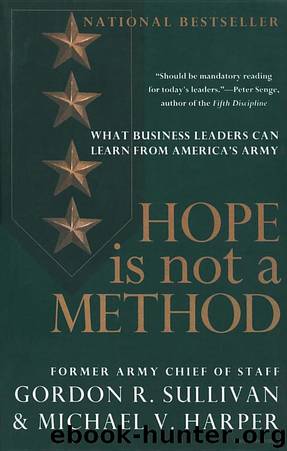Hope is Not a Method by Gordon R. Sullivan

Author:Gordon R. Sullivan [Sullivan, Gordon R.]
Language: eng
Format: epub
Publisher: The Crown Publishing Group
Published: 2010-04-29T04:00:00+00:00
SUCCESSION PLANNING:
LOOKING TWO UP AND TWO DOWN
Building a team includes succession planning, and this, too, can be difficult. Picking people is difficult because it is difficult to evaluate potential. It is much easier to measure past performance, so most promotions, in spite of our best intentions, are based primarily on performance. But as you go up the ladder, your task does not get harder so much as it becomes different, and past performance becomes less and less valuable as a predictive tool.
As a junior officer or manager, you are running things. As you become more senior, the creative dimension of your job begins to dominate the managerial dimension, and your adaptive and generative skills become more important than your technical skills. You become more involved with creating the future. You are team building at every level, but that too becomes more complex as You get nearer the top.
This difficulty notwithstanding, a leader must spend countless hours building and rebuilding the team—doing succession planning. The depth to which you plan depends somewhat on the turnover in key positions, but we suggest planning “two up and two down.” In our case, as we looked at an individual, whether a junior captain or a senior general, we tried to look at least two moves beyond his or her present position. For our junior people, it was at best a generalized process, centrally controlled but somewhat decentrally executed. For our senior people, it was a much more precise process including trying to have a follow-on assignment in mind when we made each selection. This process was joined in by all of the senior generals; essentially, the top team assisted in the selection of those who would join its level or the next two levels down. For critical jobs, we attempted to keep available a bench of qualified people, always more than one, so that when the time came to make a choice, we had options. That kind of succession planning was our way of dealing with the challenge of evolving skills as people go up the ladder. By trying to look ahead several years and by always thinking in terms of options and not necessarily in terms of individuals, we could help people grow at the same time that we could, however subjectively, evaluate potential.
Leaders cannot do it alone. Creating the future is truly a team sport. Mike Malone’s lesson for the Army is a lesson for everyone. The power to achieve is at our fingertips—it lies in the people in our organizations. By forging them into teams and by building teams of teams that are empowered by values, vision, and a strategy to grow, they will turn our visions into reality and create the future.
Download
This site does not store any files on its server. We only index and link to content provided by other sites. Please contact the content providers to delete copyright contents if any and email us, we'll remove relevant links or contents immediately.
Hit Refresh by Satya Nadella(8854)
The Compound Effect by Darren Hardy(8505)
Change Your Questions, Change Your Life by Marilee Adams(7371)
Nudge - Improving Decisions about Health, Wealth, and Happiness by Thaler Sunstein(7240)
The Black Swan by Nassim Nicholas Taleb(6762)
Deep Work by Cal Newport(6562)
Daring Greatly by Brene Brown(6221)
Rich Dad Poor Dad by Robert T. Kiyosaki(6174)
Principles: Life and Work by Ray Dalio(5957)
Man-made Catastrophes and Risk Information Concealment by Dmitry Chernov & Didier Sornette(5645)
Playing to Win_ How Strategy Really Works by A.G. Lafley & Roger L. Martin(5492)
Digital Minimalism by Cal Newport;(5389)
Big Magic: Creative Living Beyond Fear by Elizabeth Gilbert(5350)
The Myth of the Strong Leader by Archie Brown(5237)
The Slight Edge by Jeff Olson(5199)
Discipline Equals Freedom by Jocko Willink(5156)
The Motivation Myth by Jeff Haden(5000)
Stone's Rules by Roger Stone(4853)
The Laws of Human Nature by Robert Greene(4770)
